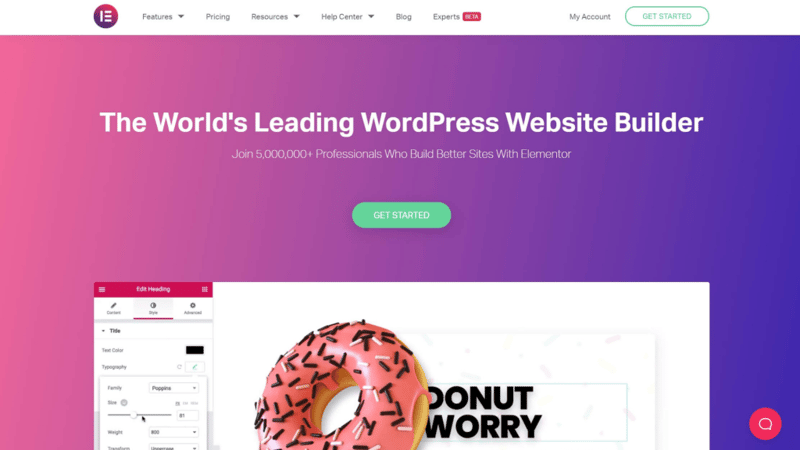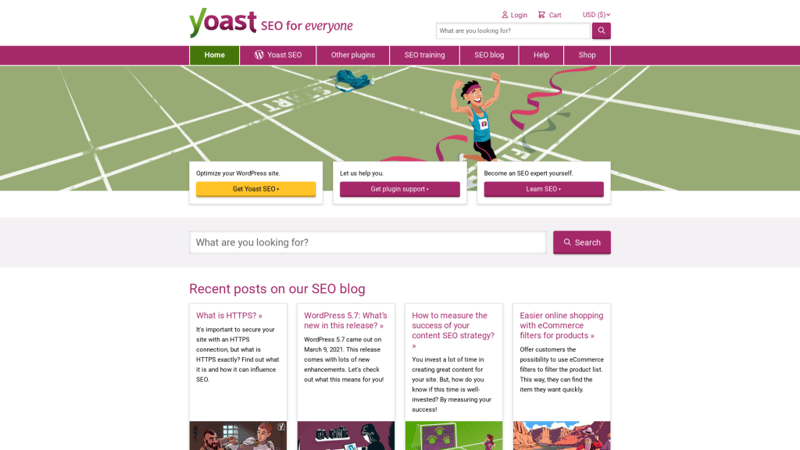Table of Contents
When building an online store, there are several options available to you in terms of choosing an ecommerce platform. WooCommerce, however, is one of the most popular WordPress plugins on the market for building an online store. It’s a powerful, free ecommerce platform that makes creating an online store super easy.
While the WooCommerce plugin itself is free to use, there are certain costs associated with running a website that users may not necessarily be aware of and, if not they are not prepared, they can get caught off guard.
In this guide, we’ll explore how WooCommerce works and what are costs associated with setting up and running a WooCommerce store. Let’s get started!
Table Of Contents
An Introduction to WooCommerce Pricing
WooCommerce is an excellent platform for building an online store:

It’s a feature-packed plugin for WordPress that is relatively simple to use. You don’t need to be a developer or even experienced with building a website to get a store up and running in no time. Designing and customizing your product pages is quick and easy.
WooCommerce also integrates seamlessly with existing WordPress sites, and the setup process is surprisingly simple. The plugin provides you with a guided wizard to help you get your online store up and running in just a few minutes. You can create listings for multiple different product types, and accept multiple payment options via PayPal, Stripe, Square, and more.
WooCommerce is also highly extensible, enabling you to customize your store to meet your specific needs. Integrations are available for Google Analytics, Mailchimp, Facebook, and hundreds of other services.
As with WordPress itself, the ecommerce plugin is open-source software that is free to download and use. Anyone can modify it to fit their needs. However, just because WooCommerce itself is free doesn’t necessarily mean that setting up a store won’t cost you anything.
There are some general costs associated with running a website that are unavoidable, such as hosting and a domain name. Additionally, if you want your ecommerce store to be successful, there are additional expenses to consider, ranging from design to marketing and analytics.
WooCommerce pricing starts with building and launching your site. Then it transitions into the recurring operating costs of a business, including maintenance, transaction fees, and marketing. We’ll explore each of these in detail in the following sections.
WooCommerce Pricing Guide: The Costs of Running an Online Store
We can broadly divide WooCommerce expenses into three categories: launching your WooCommerce site, building your store, and operating your business. Each phase can be either reasonably affordable or extremely expensive, depending on your budget and how much you’re willing to invest. It also matters whether you want to go the DIY route or outsource everything.
Let’s explore each of the three phases in more detail.
1. The Costs of Launching a WooCommerce Store
When launching your WooCommerce store, the first costs you’ll need to consider are for hosting and a domain. While the WooCommerce plugin is free, you’ll need to install it on a WordPress site. That means you’ll need a web host to house that site, as well as a domain name so that people can actually find it.
WordPress Hosting
A web host provides a server that contains your website, making it available to online users. There is a wide variety of hosting providers to choose from.
They range from affordable, budget-minded companies to managed or dedicated WordPress hosts that essentially take care of your site for you. As such, WordPress hosting costs can vary wildly depending on the type of plan you sign up for.
To give you a better idea of how wide that range is, hosting plans can start as low as $5 to $10 per month and go all the way up to several thousand dollars per month. Fortunately, you likely won’t need to pay that much (unless you’re looking for an enterprise-level solution).
Typically, a basic WordPress hosting plan will cost somewhere between $10 and $40 per month, depending on which provider you choose and the specific features you need. It’s also worth noting that your hosting costs may increase as traffic to your site goes up – although, at that point, your store will hopefully be doing well enough to support the expense.
Domain Name
Once you have a hosting plan in place, you’ll need to register a domain name. This URL is your site’s address on the web and enables users (and search engines) to actually find and visit your store. Domain names typically include a short word or phrase and a ‘domain extension‘ such as “.com” or “.net” (for example, “yoursite.com”or “example.net”).
Domains are usually much cheaper than hosting, but the cost can vary slightly depending on the extension you want and how in-demand the name is. You can expect to pay around $10 per year for most domains.
2. The Costs of Setting Up a WooCommerce Store
Next, it’s time to start setting up your WooCommerce store. The main costs here come in the form of themes, website design, and a security package. Let’s take a closer look at these elements.
Themes and Website Design
Your new storefront is going to need to look its best if you want it to be successful. However, while appearance is important, a WooCommerce theme should also be functional and provide easy access to all the features customers will need for easy shopping.
While WooCommerce does come with the dedicated Storefront theme, it’s a bit barebones and bland out of the box. You may want to invest in a designer to spruce up the theme or go with another option entirely.
You can pay to have a custom site built. Design services can be costly, but you often get what you pay for. When it comes to something as important as your online storefront, you’re probably better off paying more to ensure that the work is as high quality as possible. In practice, this means you’ll likely end up spending a few thousand dollars for a well-designed, responsive custom theme.
On the other hand, there are many excellent and customizable pre-made themes and website builders available that you can use to design your own site. For example, Elementor offers everything you need to build a highly-effective WooCommerce store:

Our platform includes a dedicated WooCommerce Builder, with prices starting at $49 per year. While you’ll still have to put the time into designing and building the site, this is an ideal option if you need to cut costs without sacrificing quality.
Website Security
Security is critical for any site, but when it comes to ecommerce (where people trust you with their financial information), it’s essential. There are a few aspects of website security that you might need to consider paying for.
The first is a Secure Sockets Layer (SSL) certificate. SSL is a protocol used to allow encrypted sites to communicate with each other. It’s required to enable Hypertext Transfer Protocol Secure (HTTPS), which keeps your customers’ data safe.
SSL certificates are not terribly expensive. Some hosts provide one for free when you register a domain name. If not, you can purchase one for around $20 per year when you pick up your domain.
Beyond the SSL certificate, you may also want to add some sort of ongoing security suite to your site. There are a number of WordPress security plugins that can handle this, offering a range of features from malware scanning and removal to firewalls. Sucuri Security is a popular option and starts at $200 per year.
3. The Operating Costs of Running a WooCommerce Store
At this point your site is hosted, your domain is registered, and you’ve set up the basics. Next, you’ll be taking your store online and dealing with the day-to-day expenses of operating an ecommerce business. These include WordPress plugins and WooCommerce extensions, website maintenance, payment processing fees, shipping, and marketing costs.
Plugins and Extensions for WooCommerce
WordPress is extremely customizable thanks to its plugin system. You can add nearly any feature you can imagine with a few clicks. The same is true for WooCommerce – there are numerous WooCommerce extensions that allow you to add new functionality to your store’s checkout, cart, shipping, payment gateways, and more.
Some of these plugins and extensions are free, but many also offer premium versions that unlock additional features. Some of the best plugins don’t have a free version at all. As such, you’ll need to factor in the costs for any of the premium plugins you want to use.
Site Maintenance Costs
WordPress sites (including WooCommerce stores) tend to require at least some upkeep to ensure that they run smoothly over time. The amount of work required varies from site to site, but maintenance services generally include tasks such as comment moderation, testing of updates, and checking performance.
Maintenance costs vary significantly. If you’re handling it yourself, you’ll be paying with your own time and resources. If you outsource to a developer, you can expect to pay between $10 and $100 per hour. Again, you usually get what you pay for, so going cheap may not be the best choice.
Payment Processing and Fees
Most of the popular payment gateways, such as Stripe or PayPal, have fees associated with them. You’ll typically pay per transaction, and some gateways also charge a flat monthly or yearly fee on top of that.
For instance, Stripe and PayPal both charge 2.9% of each transaction, plus a flat $0.30 per sale. Neither requires a monthly or annual fee.
Shipping Services
If your WooCommerce store is selling physical goods, you’ll need to account for shipping costs. These fall into two categories: costs for the services you use, and costs for the shipping itself. Shipping fees vary widely depending on the item and where it’s being sent, so we’ll focus on the service part of that equation.
WooCommerce by default includes connections for USPS and Canada Post via the WooCommerce Shipping & Tax extension. This tool enables you to create labels and handle details right from the WooCommerce dashboard. If you want to add other services, such as UPS or FedEx, you’ll need additional extensions, which can come with monthly fees attached.
Marketing Costs
Marketing and advertising are essential aspects of any successful business. After all, if people can’t find your store on the internet, they won’t be able to buy your products. Online marketing is a broad category with many aspects, but we’ll focus on two of the most common: Search Engine Optimization (SEO) and email marketing.
SEO plugins are commonly used on WordPress sites to help ensure that your pages rank as highly as possible, and increase your store’s chances of being found. These tools analyze your content and offer useful, actionable advice for improving it.
Yoast SEO is the most popular WordPress SEO plugin. It offers a free version, but to get the most out of it you’ll likely want to upgrade to the premium tier:

A license starts at $89 per year, and this plugin also supports integration with Elementor. All in One SEO is another solid option, with prices starting at $49.50 per year.
You may also want to invest in an email marketing platform for your business. Nearly 60% of marketers say that email offers the best Return on Investment (ROI), so taking advantage of this channel is wise.
Fortunately, there are a number of email marketing platforms that integrate with WordPress and WooCommerce. Mailchimp is one of the most popular options, and it starts at $9.99 per month. It also offers excellent WooCommerce integration.
Website Analytics
Analytics are critical for knowing where your business is at and where it’s going. These metrics help you get to know your customer base and make informed decisions for future growth.
Google Analytics is a top option for WooCommerce users, and is completely free:

However, you may want a little more than what the free tier offers, particularly in terms of user-friendliness and WooCommerce-specific features. If so, you might consider investing in a premium service. For example, the advanced WooCommerce Google Analytics Pro extension is $79 per year and will help you get a lot more out of your site’s key metrics.
WooCommerce Pricing Summary
Is It Necessary or Optional? | Average Cost | |
Hosting | Necessary | $10–$40 per month |
Domain Name | Necessary | $10 per year |
Website Theme | Optional | $49 per year |
Security | Necessary | $20 per year for an SSL certificate, $200 per year for a security suite |
Plugins and Extensions | Optional | $49 per year per plugin |
Website Maintenance | Optional | $10–$100 per hour, as needed |
Payment Processing | Necessary | 2.9 percent plus $0.30 per transaction |
Shipping Services | Necessary (for physical products) | $79 per year per service |
Marketing | Optional | $89 per year |
Analytics | Optional | $79 per year |
WooCommerce Is Free, but Business Is Not
WooCommerce is an amazing ecommerce platform. It’s packed with features and makes setting up an online store as easy and fast as possible.
However, while the plugin itself may be free, running an online business is not. There are a lot of hidden costs associated with building and running an online store. From hosting and security to site design, WooCommerce extensions, and marketing costs, a WooCommerce online store can be expensive, so it’s important to know what you’re getting into upfront.
Do you have any questions about WooCommerce pricing? Let us know in the comments section below!
Looking for fresh content?
By entering your email, you agree to receive Elementor emails, including marketing emails,
and agree to our Terms & Conditions and Privacy Policy.






